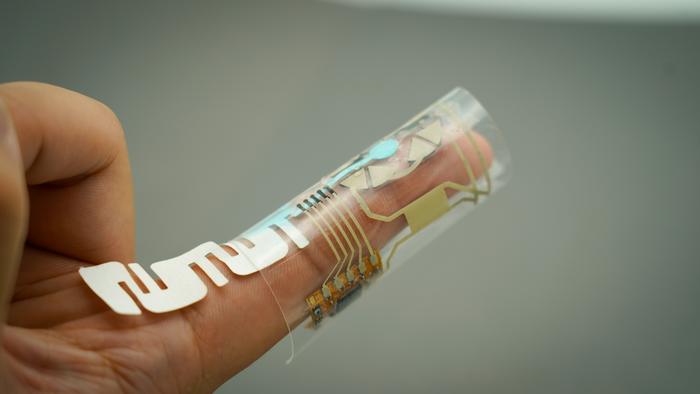
A sweat-powered wearable has the potential to make continuous, personalised health monitoring as effortless as wearing a plaster, new research has found.
Engineers at the University of California San Diego have developed an electronic finger wrap that monitors vital chemical levels—such as glucose, vitamins, and even drugs—found in sweat.
The device, which wraps snugly around the finger, draws power from an unlikely source—the fingertip’s sweat.
Fingertips, despite their small size, are among the body’s most prolific sweat producers, each packed with over a thousand sweat glands.
These glands can produce 100 to 1000 times more sweat than most other areas of the body, even during rest.
This constant trickle of natural perspiration—without any stimuli or physical activity—offers a reliable energy source, fueling the device even during periods of inactivity or sleep.
Study co-first author Shichao Ding is a postdoctoral researcher in Wang’s research group at the UC San Diego Jacobs School of Engineering.
The researcher said: “This is automatic health monitoring at your fingertips.
“The wearer can be resting or asleep, and the device can still harvest energy and track biomarker levels.”
The device is constructed from several electronic components printed onto a thin, flexible and stretchable polymer material.
Its design allows it to conform to the finger while being durable enough to withstand repeated bending, stretching and movement.
Wang said: “It is based on a remarkable integration of energy harvesting and storage components, with multiple biosensors in a fluidic microchannel, along with the corresponding electronic controller, all at the fingertip.”
Central to its operation are biofuel cells that are positioned where the device contacts the fingertip.
These cells have been specially engineered to efficiently collect and convert chemicals in sweat into electricity.
This electricity is stored in a pair of stretchable, silver chloride-zinc batteries, which power a suite of sensors—four in total—each tasked with monitoring a specific biomarker: glucose, vitamin C, lactate and levodopa, a drug used for treating Parkinson’s disease.
As sweat is wicked through tiny paper microfluidic channels to these sensors, the device analyses the biomarker levels, all while drawing energy it needs from the very sweat it’s sampling.
A small chip processes signals from the sensors and wirelessly transmits the data via Bluetooth low energy to a custom-designed smartphone or laptop application.
In tests, a subject wore the device throughout the day to track glucose levels during meals, lactate levels during both desk work and exercise, vitamin C levels while drinking orange juice, and levodopa levels after eating fava beans, a natural source of the compound.
Ding and co-first author Tamoghna Saha say that the device can be customised to cater to individual health needs by detecting different sets of biomarkers.
The researchers are working on developing a closed-loop system that not only monitors biomarkers, but also administers treatments based on the collected data.
For instance, in the case of diabetes, such a device could continuously monitor glucose levels and automatically deliver insulin as needed, then assess the treatment’s effectiveness by further monitoring biomarker levels.
Ding said: “Autonomous power, sensing and treatment all in one device—that’s the ultimate goal.”
Image: Shichao Ding





